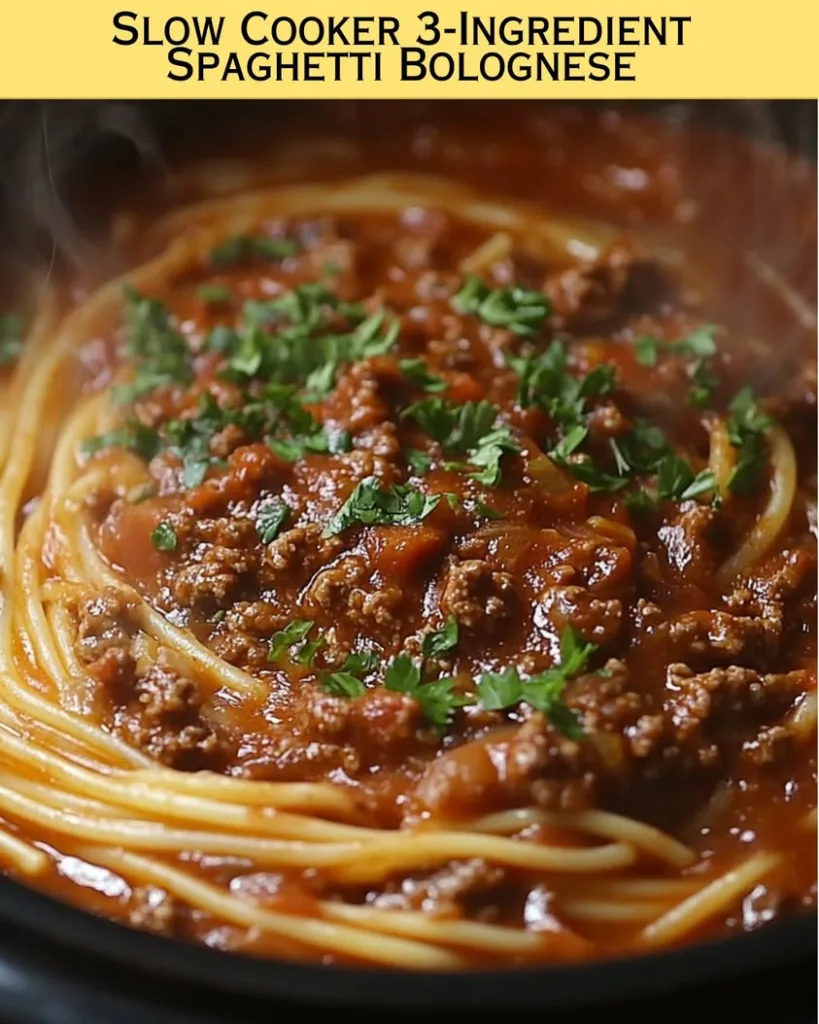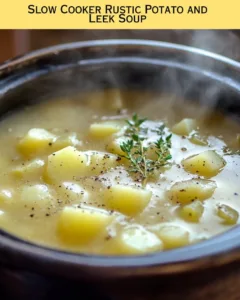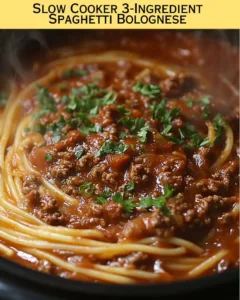Slow Cooker 3-Ingredient Spaghetti Bolognese: A Simple and Delicious Meal
Are you searching for a quick and satisfying dinner option? Look no further than this Slow Cooker 3-Ingredient Spaghetti Bolognese! This easy-to-make recipe combines the rich flavors of traditional Italian cuisine with the convenience of a slow cooker. Just set it and forget it while the aroma fills your home, creating a welcoming atmosphere perfect for family gatherings or a cozy evening in.
With just three main ingredients, this Spaghetti Bolognese recipe is not only flavorful but also incredibly easy to prepare. Imagine tender spaghetti paired with a rich, meaty sauce that has simmered all day. Each bite delivers a taste sensation that is both comforting and heartwarming. The simplicity of this recipe makes it an ideal choice for busy weeknights or when you want to impress guests without spending all day in the kitchen.
Quick Recipe Highlights
- Flavor Profile: This dish features a robust, savory experience with the perfect balance of sweetness from tomatoes and a delightful umami kick.
- Texture: The spaghetti is perfectly cooked, complemented by a hearty, thick sauce that clings to each strand.
- Aroma: Expect an enticing blend of simmered meat and fragrant tomatoes that fills your kitchen with warmth.
- Visual Appeal: The deep red color of the sauce against the pale pasta creates a beautiful presentation that is sure to impress.
- Skill Level Needed: This recipe is ideal for beginners but can also satisfy the more experienced cooks looking for a no-fuss meal.
- Special Equipment: A slow cooker is essential for this recipe to achieve that fall-apart tenderness with minimal effort.
Recipe Overview
- Difficulty Level: This Spaghetti Bolognese is labeled easy, making it perfect for cooks of all skill levels. Even if you’re new to slow cooking, you’ll find it straightforward.
- Category: This dish falls under main courses, making it a hearty option for lunch or dinner, and it’s ideal for meal prep.
- Cuisine: Rooted in Italian tradition, this recipe showcases the flavors typical of the classic Bolognese, with a simplified approach suitable for all home cooks.
- Cost: Budget-friendly, this meal costs under $10 to serve four people, making it an economical choice for families or friends.
- Season: This dish shines any time of year, but its warmth makes it especially comforting during colder months.
- Occasion: Perfect for family dinners, casual get-togethers, or weeknight meals, this Spaghetti Bolognese fits any occasion.
Why You’ll Love This Recipe
First and foremost, the taste and texture of this Slow Cooker 3-Ingredient Spaghetti Bolognese are sure to captivate your palate. The delightful combination of the rich meat sauce and tender spaghetti leads to a satisfying meal that appeals universally, whether for little ones or grown-ups.
Convenience is at the forefront of this recipe’s appeal. Simply toss the ingredients into the slow cooker and let it do the work for you! You can spend more time with your loved ones while your meal simmers to perfection.
Nutritionally, this dish presents a balanced meal option with protein and carbohydrates. You can easily pair it with a side salad for added vitamins and minerals, making it a wholesome choice without sacrificing flavor.
This recipe is also great for social gatherings. Its generous yield feeds a crowd without requiring extensive time in the kitchen, allowing you to focus on entertaining rather than being tied to the stove.
Lastly, its cost-effectiveness cannot be overstated. With economical ingredients that are often pantry staples, this recipe allows you to serve a delicious meal without breaking the bank.
Historical Background and Cultural Significance
The origins of Bolognese sauce date back to the late 18th century in Bologna, Italy. The traditional recipe has evolved over time, with various regions adding distinct local flavors, but the core principles remain the same—using high-quality meat, tomatoes, and slow cooking to develop rich flavors.
Culturally, Bolognese sauce is a staple in Italian households and epitomizes comfort cooking. It is often served at family gatherings, showcasing the communal approach to meals that Italians cherish.
As this recipe has evolved, numerous adaptations have occurred, particularly as Italian cuisine has gained popularity worldwide. Today, variations include everything from vegetarian to gourmet takes on the classic sauce.
There are also regional variations across Italy, with some places preferring more vegetables, while others emphasize meat. Each version tells a story of local agriculture and culinary traditions, marking Bolognese as a dish that brings people together.
Ingredient Deep Dive
Ground Beef: Ground beef serves as the base of this hearty sauce. Not only is it rich in protein, but it also adds depth and flavor to the dish. When selecting ground beef, opt for lean options for a healthier meal. Store any leftovers properly in the refrigerator for up to three days.
Canned Tomatoes: Canned tomatoes provide the perfect acidity and sweetness to the sauce. They are versatile and can be used in a multitude of dishes. When purchasing canned tomatoes, look for those labeled “San Marzano” for authentic flavor. Store opened canned tomatoes in an airtight container in the fridge for maximum freshness.
Spaghetti: The choice of pasta can elevate the dish. Opt for high-quality spaghetti that holds onto the sauce well. The nutritional benefits of pasta include energy-providing carbohydrates. Cooked spaghetti can be refrigerated for up to three days, making it great for meal prep.
Common Mistakes to Avoid
- Using low-quality meat can result in a flavorless sauce. Always choose fresh, well-marbled beef to enhance taste.
- Overcooking the sauce can lead to a burnt flavor; stick to the recommended cooking time for tender results.
- Skipping the browning step for meat can prevent essential flavors from developing; always brown your beef before slow cooking.
- Using too much liquid may create a watery sauce; monitor liquid levels to achieve a thicker consistency.
- Not seasoning adequately during cooking can result in a bland dish. Adjust seasoning as it simmers for balanced flavor.
- Failing to use enough spaghetti can cause the sauce-to-pasta ratio to be off. Ensure a generous portion of pasta in each serving.
- Forgetting to taste your dish before serving can mean missing out on critical adjustments that enhance flavor.
- Not allowing enough time for the ingredients to meld can lead to a less flavorful sauce, so let it cook through.
Essential Techniques
Browning the meat: This crucial step adds depth of flavor through the Maillard reaction. To master it, ensure your pan is hot and do not overcrowd it. Wait until the meat is well-browned before flipping for the best results.
Slow cooking: Understanding your slow cooker is important—low and slow can lead to tender meats and rich sauces. Master this technique by checking doneness towards the end to avoid overcooking.
Pro Tips for Perfect Slow Cooker 3-Ingredient Spaghetti Bolognese
1. Use a good quality wine while cooking for added richness and depth of flavor.
2. For an extra punch, add a splash of balsamic vinegar near the end of cooking to brighten flavors.
3. Consider adding herbs like basil or oregano for an aromatic touch.
4. If you plan to freeze leftovers, ensure the sauce is cooled down before transferring it to containers.
5. Experiment with different ground meats, like turkey or chicken, for lighter variations.
6. Always use fresh garlic and onions for enhanced flavor profiles.
7. Pair your spaghetti with a side of garlic bread and a fresh salad for a complete meal.
8. Adjust the cooking time according to the size of your meat batch for consistent results.
Variations and Adaptations
Explore regional variations of this recipe; for example, adding mushrooms or carrots can create a more complex flavor profile while staying true to the heart of the dish.
Seasonal adaptations are also possible. For a summery twist, incorporate fresh basil or zucchini for a lighter take on the classic sauce.
Dietary modifications can easily cater to vegetarian diets by substituting the meat with lentils or mushrooms, maintaining a robust flavor while offering plant-based nutrition.
Flavor variations can be created by adding different spices or sauces. A dash of chili flakes can bring heat, or experiment with smoked paprika for a unique twist.
Texture modifications, such as using spaghetti squash instead of traditional spaghetti, provide a lower-carb alternative while still being delicious.
Lastly, presentation alternatives like serving in bowls with a sprinkle of grated Parmesan can elevate the dining experience.
Serving and Presentation Guide
For plating, twirl the spaghetti into nests using a fork or tongs for a clean presentation on each plate. Top with a generous ladle of the Bolognese sauce, and finish with a sprinkle of fresh herbs or grated cheese.
Garnishing with a sprig of basil or a sprinkle of parsley adds a pop of color and freshness. This enhances the visual appeal of your meal, making it more inviting.
Pairing with traditional accompaniments like garlic bread and Caesar salad harmonizes with the dish, creating a complete meal experience.
Modern serving suggestions may include presenting the dish family-style in a large bowl, encouraging sharing among guests and fostering a warm atmosphere.
Temperature considerations are essential; serve the Bolognese hot, and ensure that the spaghetti is well-drained to avoid sogginess.
For portion control, consider using smaller plates or bowls, allowing guests to enjoy seconds without overwhelming their plates.
Wine and Beverage Pairing
For wine pairings, a robust red like Chianti or Merlot complements the heartiness of Bolognese. The acidity in these wines balances the richness of the meat and tomato sauce.
Non-alcoholic alternatives like sparkling water with a twist of lemon also provide a refreshing contrast and cleanse the palate.
If enjoying coffee or tea, consider a rich espresso or herbal tea for after the meal, aiding digestion and wrapping up your dining experience delightfully.
Temperature considerations matter; serve red wines at room temperature for optimal flavor.
For serving suggestions, offer wine in stemware to enhance the experience, enhancing visual appeal at the dinner table.
Storage and Shelf Life
For proper storage, allow the Bolognese sauce to cool fully before transferring to airtight containers. It can be stored in the fridge for up to three days, keeping flavors intact.
The ideal temperature for storage is below 40°F to prevent bacterial growth. For long-term storage, consider freezing the sauce, where it will last for up to three months.
Use glass or BPA-free plastic containers to avoid contamination, ensuring safe storage practices. Issues such as freezer burn can be avoided by wrapping containers tightly with plastic wrap.
Signs of spoilage include unusual smells or mold, which indicate the food should not be consumed.
Reheating should be done on the stove or in the microwave until steaming hot, ensuring it’s safe to eat. Thaw frozen portions in the refrigerator before reheating for best results.
Freezing guidelines suggest labeling containers with the date for easy tracking of freshness.
Make Ahead Strategies
Prep time can be minimized by chopping onions and garlic a day in advance, ensuring quick assembly on the day of cooking.
Store ingredients separately to maintain freshness; this also allows for flexibility in adjusting proportions of sauces or pasta according to personal preference.
Assess the impact on quality thoroughly—cooked spaghetti may not hold well overnight versus the Bolognese sauce, which improves in flavor.
When assembling, layer spaghetti and sauce in individual containers for lunch prep. This makes it easy to reheat and serve quickly during busy weekdays.
Fresh elements, such as herbs, should be added after reheating to keep them vibrant and impactful in flavor.
Scaling Instructions
For halving the recipe, simply divide the ingredients in half, but keep an eye on the cooking time, as smaller batches may require less simmering.
For doubling or tripling, ensure your slow cooker can accommodate the volume—sometimes using separate batches may yield better results than overcrowding the pot.
Equipment adjustments may include using a larger pot if scaling significantly and considering the size of your cooking appliances.
Timing modifications may be necessary, as larger quantities can take longer to reach the right temperature; running a test on doneness can help achieve optimal results.
Finally, storage considerations for leftovers should align with how many servings you anticipate; this minimizes waste and maximizes flavor quality.
Nutritional Deep Dive
Each serving offers a balanced macro breakdown, including proteins from the meat, carbohydrates from the pasta, and healthy fats, especially if prepared with olive oil or cheese.
Micronutrient analysis highlights vitamins and minerals, particularly from the tomatoes, which provide Vitamin C, potassium, and antioxidants.
Health benefits of this dish include high protein content, which is essential for muscle repair, and fiber from the tomato base, aiding digestion.
Dietary considerations allow for adjustments to cater to various nutritional needs, such as gluten-free or lower carb versions.
This dish is well-portioned to assist in weight management, ensuring adequate energy without excessive calories.
Dietary Adaptations
To cater to gluten-free diets, simply substitute regular spaghetti for gluten-free pasta, which maintains the essence of the dish.
Dairy-free adaptations can be achieved by omitting cheese or replacing it with nutritional yeast for a cheesy flavor without dairy.
For vegan versions, use lentils or mushrooms in place of ground meat, ensuring to enhance the sauce with spices for depth.
Low-carb adaptations include using spiralized vegetables like zucchini instead of traditional pasta.
Keto and paleo diets can also be accommodated with creative substitutions, focusing on high-quality meat and low-carb vegetables.
Finally, low-FODMAP options are possible by avoiding high FODMAP ingredients like onions and switching to safe alternatives.
Troubleshooting Guide
If you experience texture issues with your sauce being too watery, consider using less liquid next time, or cook the sauce uncovered for the last hour to thicken it.
For flavor balance concerns, always taste and adjust seasonings; a pinch of salt or a splash of vinegar can enhance the overall flavor.
Temperature problems can arise if the slow cooker settings are misread; ensure you’re consistently cooking on low for ideal simmering.
If equipment challenges come into play, check that your slow cooker functions properly, as some models may not adequately heat or cook ingredients.
Ingredient substitutions can lead to unexpected results, so always remember that different brands and types can affect cooking times and flavors.
Lastly, timing concerns often stem from not taking ingredient sizes into account; always ensure uniformity in size for even cooking.
Recipe Success Stories
Community feedback has been overwhelmingly positive, with readers emphasizing the ease of preparation and the delicious final product. Many have shared their excitement over how quickly this dish has become a household favorite.
Variation successes highlight the adaptability of this recipe, as home cooks have embraced swapping ingredients based on personal preferences, leading to new family traditions.
Adaptation stories from readers have showcased how this recipe was utilized for special occasions, with personal touches enhancing its original form and making it uniquely theirs.
Photography tips from the community illustrate how plating techniques can enhance the visual appeal; many encourage natural lighting to best capture the dish for social sharing.
Frequently Asked Questions
Can I use other types of meat? Absolutely! Ground turkey, chicken, or even plant-based alternatives can work well in this recipe.
How long can leftovers be stored? Leftovers can last in the fridge for up to three days and can be frozen for longer storage.
Can I make this ahead of time? Yes! You can prepare the ingredients a day in advance and refrigerate them until you’re ready to put them in the cooker.
How can I thicken the sauce? If your sauce is too runny, you can simmer it uncovered for the last hour or add a cornstarch slurry.
Is it necessary to brown the meat? Browning the meat enhances flavor through the Maillard reaction, so it’s highly recommended!
Can I add vegetables to the sauce? Yes! Feel free to include bell peppers, mushrooms, or spinach towards the end of the cooking time for added nutrition.
What type of canned tomatoes should I use? Look for high-quality diced or crushed tomatoes, preferably San Marzano for the best flavor.
Is this recipe spicy? This recipe is not inherently spicy, but you can add chili flakes if you prefer some heat.
What type of salt should I use? Feel free to use kosher salt, sea salt, or even table salt; just adjust to taste.
Can I make this a vegetarian dish? Yes! Replace ground meat with lentils or mushrooms to create a delicious vegetarian alternative.
Additional Resources
For those interested in exploring more recipes, check out our collection of Italian dishes, including lasagna and risotto. These recipes pair beautifully with Spaghetti Bolognese.
Technique guides on slow cooking and pasta preparation can help enhance your culinary skills, ensuring perfect results every time.
Learn about ingredient information by exploring the benefits of various types of pasta, and the importance of tomatoes in cooking.
Equipment recommendations can also be beneficial; selecting the right slow cooker can make a significant difference in your cooking experience.
Don’t forget to explore seasonal variations, as different ingredients can transform classic recipes into fresh takes that celebrate the seasons.
Join the Conversation
We love hearing from you! Share your thoughts on this recipe and connect with us on social media. Whether you’re sharing a photo of your delicious results or providing feedback, your input helps our community thrive.
Photography tips can also help capture your culinary creations. Consider natural lighting and minimal distractions in your background for the best results on social platforms.
Your recipe reviews are invaluable; they not only assist other readers in their journey but help us improve and connect with cook enthusiasts worldwide.
Don’t hesitate to engage! Share your variations, ask questions, or simply connect over your love of cooking; we welcome every member in this joyful community.
The Recipe
Slow Cooker 3-Ingredient Spaghetti Bolognese
Serves: 4
Prep Time: 10 mins
Cook Time: 6 hours
Total Time: 6 hours 10 mins
Kitchen Equipment Needed
- Slow Cooker
- Skillet
- Cutting Board
- Knife
- Serving Spoon
Ingredients
- 1 lb ground beef
- 1 can (28 oz) diced tomatoes
- 8 oz spaghetti
Directions
- Brown the ground beef in a skillet over medium heat; drain excess fat.
- Transfer the browned meat to the slow cooker, then add the canned tomatoes.
- Set the slow cooker to low and cook for 6 hours.
- About 30 minutes before serving, cook the spaghetti according to package instructions.
- Serve the Bolognese sauce over the cooked spaghetti and enjoy!
Recipe Notes
- This recipe can easily be adjusted for larger gatherings by multiplying the ingredient amounts.
- Feel free to include chopped vegetables or herbs for added flavor.
- Leftover Bolognese can be frozen for future meals.










